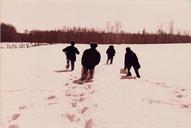

|
Artworks: Click here | |
| Collective action group (KD) |
"Collective Action" was founded by Andrei Monastyrsky, Nikolai Panitkov, Nikita Alekseev, and Georgii Kizevalter (later joined by Igor Makarevich, Elena Elagina, Sergei Romashko, and Sabina Hensgen). Actions were staged for the benefit of a specially invited audience, mostly friends; the social alienation from the audience that often motivated Western performance art was entirely absent here, and thus the group had to cultivate intellectual alienation instead. Viewers had to ride the train to the outskirts of the city, walk a certain distance on foot, and meticulously obey the artists` strange instructions in an anxious state of expectation and confusion (this state was termed "empty action"). The viewers actively experienced existential ennui and, at the same time, intrigue, since the boundaries of performance remained unclear both spatially and temporally right up to the end. These performances were painstakingly documented and the resulting commentary comprised several volumes entitled "Trips Out of Town."
"Collective Action"`s early performances appeared purely minimalist and presented everyday yet ontologically weighty situations: receiving visual information ("The Appearance," 1976, during which a man appears coming out of the woods); effects of the unexpected ("Liblikh, 1976, in which a bell rings from under the snow); awaiting the end ("The Time of Action," 1978, during which the audience spent hours pulling a long rope out of the woods, not knowing why or when this would end). Part of the performance was theatrical, yet the point was not in the spectacle, but in the expectation and perception of the audience and even chance passers-by, who might later stumble upon strange objects in the woods. Like many Russian avant-garde and neo-avant-garde phenomena, "Collective Action" explored and manipulated psychological categories.
The group`s later performances revolved around an almost cinematographic montage, temporarily destroying continuity and creating tension between immediate existence and its recording. In "The Stop" (1983), as audience members walked to what they believed to be the performance site, two performers followed them inconspicuously, tape-recording their description of what they saw—as it became evident when the group "stopped," this had been the performance itself, with the encounter with the audience as the finale. At the first "hello," the tape-recorder was shut off. In the performance "Ten Appearances" (1981), the audience was instructed to walk from the center of a field deep into the woods and then return, at which point each person was handed a photograph of his "appearance" coming out of the woods (the photographs had been taken beforehand, of other people).
The desired category of freedom came to be seen as a struggle against text, against exact recording. However, Zen philosophy, with its mystical atheism, liberates the work of Monastyrsky and "Collective Action" from the gnawing sense of textual incompleteness which hovers around Kabakov`s work. This also distinguishes Monastyrsky`s individual projects created in the 1980s — texts and installations in which he discovers curious correspondences between the Agricultural Exhibition pavilions, biographical details about "Collective Action" members, hexagrams of the I Ching, and various other aspects of his personal mythology. These works demonstrate his immersion in "interpretational ecstasy" as a shamanistic practice, which does not allow the possibility of regretting the absence of anything. Here minimalism becomes a sort of intellectual mannerism, characteristic of the younger conceptualists of the 1980s as well..."
Ekaterina Degot`s article
Request
more information about artist
© 1994-2024 ARTINFO
All rights reserved
designed by ARTINFO
hosted by ARTINFO